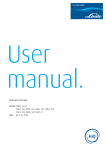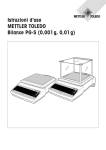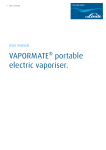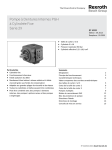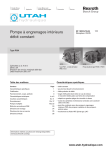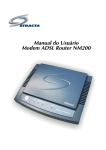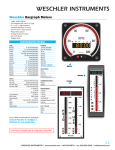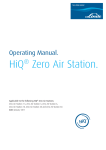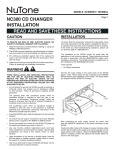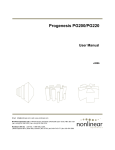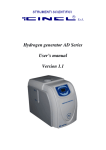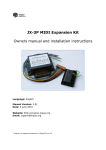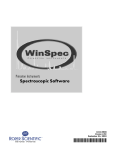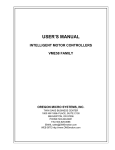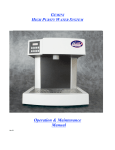Download The HiQ® Hydrogen PG gas generator
Transcript
User manual. Hydrogen Generator Models PGH2 Series PGH2 100, PGH2 160, PGH2 250, PGH2 300, PGH2 500, PGH2 600 Date June 18, 2008 02 PGH2 Series Table of contents. Introduction Scope of the manual Specifications Notes on FCC compliance Correct use Packing list 3 3 3 4 4 5 Description 6 Installation 7 Receiving the generator Placing the generator Symbols used on the generator Gas connections Cartridge installation Electrical connections Remote connections (optional) Cascading (optional) Auto refill (optional) Initial start-up Filling the water tank Installing the deioniser bag Starting the unit Operation LEDs Liquid crystal display (LCD) The keypad Menu tree Maintenance Routine maintenance Returning the unit Spare parts list 7 7 7 7 8 10 10 11 12 13 13 13 14 15 16 16 18 19 22 22 23 24 HiQ® is a registered trademark of The Linde Group. PGH2 Series 03 Introduction. Scope of the manual This manual provides operation and maintenance instructions for the Hydrogen Generator models PGH2 100, PGH2 160, PGH2 250, PGH2 300, PGH2 500 and PGH2 600. Specifications Specifications of the different Hydrogen Generator models Hydrogen flow rate Model PGH2 100 STP: Standard temperature and Model PGH2 160 pressure (20 °C, 1 bar) Model PGH2 250 Model PGH2 300 Model PGH2 500 Model PGH2 600 Max outlet pressure 7 bar (100 psi) Purity 99.999 % Models PGH2 100, 160, 250, 300 Weight (dry) Models PGH2 500, 600 Model PGH2 100 Power consumption Model PGH2 160 Model PGH2 250 Model PGH2 300 Model PGH2 500 Model PGH2 600 Input voltage 110–230 V/50–60 Hz Fuse (not user-replaceable) 5 x 30, 6.3 A Pressure accuracy 0.1 bar (±0.5 %) Microprocessor-controlled display LCD Index of protection IP2x Operating conditions: 3 Temperature 3 Relative humidity +15° C to +40° C 80 % up to 31° C, decreasing linearly to 50 % at 40° C Over voltage category Pollution degree Sound pressure level Case dimensions II 2 46 dB(A) 220 x 330 x 395 mm (W x D x H) 0–100 ml/min at STP 0–160 ml/min at STP 0–250 ml/min at STP 0–300 ml/min at STP 0–500 ml/min at STP 0–600 ml/min at STP 16 kg 18 kg 70 VA 95 VA 140 VA 160 VA 280 VA 310 VA HiQ® code 5517 5518 5519 6001 5520 6002 04 PGH2 Series Notes on FCC compliance This equipment has been tested and found to comply with the limits for a Class B digital device pursuant to part 15 of the FCC rules. These limits are designed to provide reasonable protection against harmful interference in a residential installation. This equipment generates, uses and can radiate radio-frequency energy and, if not installed and used in accordance with the instructions, may cause harmful interference to radio communications. However, there is no guarantee that interference will not occur in a particular installation. If this equipment does cause harmful interference to radio or television reception, which can be determined by turning the equipment off and on, the user is encouraged to try to correct the interference by one or more of the following measures: 33 Reorient or relocate the receiving antenna. 33 Increase the separation between the equipment and the receiver. 33 Connect the equipment to an outlet on a circuit different from that to which the receiver is connected. 33 Consult the dealer or an experienced radio/TV technician for help. Correct use The Hydrogen Generator is designed to produce hydrogen for laboratory use. The unit must only be operated for this purpose, according to the specifications and instructions provided in this manual. In particular, the following warnings must be observed at all times: 33 Indoor use only. 33 Never operate the unit at below-zero temperatures. This will cause irreversible damage to the electrolysis cell. 33 Only use pure water (see “Filling the water tank”). 33 Only operate the unit in a room with sufficient ventilation (see “Placing the generator”). 33 Always unplug the unit from the mains power supply before accessing the internal components for replacement. 33 Only the parts described in the “Spare parts list” can be replaced by the user. Warning Any changes or modifications to this equipment not expressly approved by the manufacturer may void the user‘s authority to operate the equipment. PGH2 Series Packing list List of items included in the shipment Quantity 1 1 1 1 1 Description Hydrogen Generator Instruction manual Deioniser triangle bag Water drain with flexible tubing Power cable 05 06 PGH2 Series Description. The Hydrogen Generator produces pure hydrogen (and oxygen as a by-product) through the electrolysis of water. The key element of the generator is an electrochemical cell assembly which contains a solid polymer electrolyte. No free acids or alkalines are used. Deionised or pure, distilled water is the only liquid which may come into contact with the cell. Because the water is consumed, it must be refilled from time to time. The generated hydrogen is accumulated in the hydrogen/water separator and the desiccant housing. The pressure is controlled by a pressure transducer. The output pressure is indicated on the display. The hydrogen is dried by passing it through a drying tube and a desiccant cartridge containing desiccant material. The hydrogen then passes through the shut-off valve and exits the generator through the outlet port at the rear. PGH2 Series Installation. Receiving the generator All units have been carefully inspected before transport. Visual checks for damage and functional tests should be performed upon receipt. Any damage must be immediately noted and reported. The generator must only be returned according to the shipping instructions provided. Placing the generator The Hydrogen Generator must be placed on a flat, level, vibration-free, shock-free surface. Do not place the generator over a source of heat, as this may cause the device to overheat. The unit should not be in contact with any other objects on any side and the air inlet must not be blocked. Leave at least 30 cm of free space at the rear for ventilation. Do not operate the generator in a sealed or unventilated room, or in close proximity to an open flame or other sources of ignition. Do not operate the generator at below-freezing temperatures. Operation is guaranteed at operating temperatures between +15 and +40° C. Warning Normal precautions for any hydrogen supply should be taken when using the generator. Do not use in sealed or unventilated rooms. Do not use in close proximity of open flames or other sources of ignition. Symbols used on the generator Earth symbol This symbol marks the earth connections to the chassis of the Hydrogen Generator. Gas connections Pure dry hydrogen at regulated pressure is available at the hydrogen outlet port at the rear of the generator. This port must be connected to 1/8" tubing using a stainless-steel or copper Swagelok connector. Teflon connectors are not suitable. The pressure at this port is adjusted and shown on the display. The hydrogen relief port at the rear of the unit can be connected to an exhaust hood or another vent system. Warning The line from the relief port should never be connected in such a way that back pressure can develop. 07 08 PGH2 Series Important Remove the plug from the oxygen vent and hydrogen vent before operating the unit. Keep these plugs for transporting the unit. Cartridge installation The desiccant cartridge is shipped separately inside the packaging, and needs to be fitted before operating the unit. Refer to the photos below for the installation of the cartridge. Make sure that the tubing that connects the cartridge is pushed back inside the unit after installation to allow the front door to close completely. Step 1 to Step 3: Preparation for cartridge installation Step 1 Step 2 Step 3 PGH2 Series Step 4 to Step 6: Cartridge installation Step 4 Step 5 Please note: When the silica gel inside the cartridge has changed its colour completely, it’s time to substitute it with a new one. Loosen the top fitting of the cartridge by unscrewing the fitting counter-clockwise, then empty the “old” molecular sieve and replace it with a new one. Make sure that the o-ring on top of the cartridge is free of dust before reinstalling the fitting. Step 6 09 10 PGH2 Series Electrical connections Check the setting of the voltage selector on the rear of the unit. The set voltage is indicated by the white arrow. To change the voltage, proceed as follows: 33 Using a small screwdriver, remove the voltage selector insert. 33 Replace the voltage selector insert so that the white arrow points to the correct voltage. Remote connections (optional) The Hydrogen Generators are fitted with an optional remote control feature, which allows the user to check the status of the machine from a remote position, and to start/stop the production of hydrogen. The contacts used in the remote control are potential-free relay contacts. The contacts can be configured via software as “Normally open” or “Normally closed” (see the “Operation” section, page 19+20). The maximum voltage and current ratings for the contacts are 1A / 48 V. The pin configuration of the remote connector is shown in the table below. Remote connector pin configuration Pin 1+2 3+4 5+6 7+8 9+10 11+12 13+14 Description Start (12 – 30 VDC, polarity not important) Standby (system not OK) Reaching normal pressure (overproduction) Refill water (low water) Low water level (water level too low) Bad water Change water (bad water warning) PGH2 Series Cascading (optional) The RS-485 interface allows up to 10 generators to be operated in parallel mode. One unit has to be defined as the master, while the others operate in “slave” mode. All the slaves need to be configured with individual ID numbers. Communication between the generators requires a standard D-sub 9 pin serial cable. The serial ports are connected as follows: Master RS-485 out 3 Slave 1 RS-485 out - Slave 1 RS-485 in 3 Slave 2 RS-485 in … Configuration Configuring the master 1. Enter “Menu”. 2. Scroll until the display shows “Master“ and press “Enter”. Set the value to “YES” (using the +/buttons). 3. E xit and scroll until the display shows “Number of slaves“ and enter: set the number of slaves connected to the master using the +/- buttons. 4. Exit and scroll until the display shows “ID Nr“ and set to “1”. 5. Exit. Configuring the slaves 1. Enter “Menu”. 2. Scroll until the display shows “Master“ and press “Enter”. Set the value to “NO” (using the +/buttons). 3. E xit and scroll until the display shows “ID Nr“ and press “Enter”. Set the ID number of the slave.Use a different number for each slave, starting from ID Nr. 2. 4. Exit. The configuration is now complete. Operating in master-slave mode Connect the gas outputs of all the generators to the same line. Open all the main valves. If the configuration and the serial connection is correct, the slaves will show “Slave mode“ after starting up. Change the pressure setting on the master and the slaves will follow the master. Important The cascading function will only work properly if the gas outlets on all the generators are connected together and the main valves are in the “OPEN” position. 11 12 PGH2 Series Auto refill (optional) Description The auto refill option gives you the possibility to refill the water tank of the generator automatically from an external water source. You can either use a DI water line or a water reservoir. The correct refill time depends on the pressure of the water source. A higher pressure results in a shorter refill time. Max. pressure is 60 psi g. If you are using a water reservoir, make sure the minimum water level in the reservoir is 2-3 feet higher than the top of the generator. Installation steps 1. C onnect the water tubes and the electric wires as shown in the diagram above. 2. Configure the generator as follows: 33 Set the generator to standby. 33 Set the auto refill function to “ON”. 33 Adjust the auto refill time to 8 s. 3. Test the auto refill time as follows: 33 Empty the water tank. 33 Start the generator. 33 Obtain the refilling level (should be approx. 30 to 50 % of the max. level). 33 If the refill level is too low, increase the auto refill time. 33 Repeat these steps until you have a correct refilling volume. 33 Note: every time you go into the “Auto refill” menu, you have to put the generator to standby and start it again. Warning If the refill time is too long, the water tank of the generator can overflow and damage the unit. PGH2 Series Initial start-up. Filling the water tank To fill the generator with water, remove the cap on the water tank. Carefully fill the tank with distilled or deionised water. The conductivity of the water used in the generator must not exceed 2µS. Fill the tank to the maximum level indicator. Replace the cap and leave the small hole free for ventilation. Warning Do not fill the water tank higher than the marked level. Caution To prevent contamination of the cell assembly, it is important to use only deionised or distilled water in the generator. Water containing metallic impurities will contaminate or damage the cell and will void the warranty. Installing the deioniser bag After having filled the tank with water, the deioniser bag (supplied) must be placed in the tank. Inspect the bag thoroughly for holes or tears, indicated by loose deioniser beads on the outer surface. If the bag is damaged in any way, discard and replace it with a new one. Only use original parts (see “Spare parts list”). Wash the deioniser bag in deionised water before proceeding. Insert the free end of the “T” fastener through the hole in the centre of the water filler cap until it is securely fastened. The bag should not block the outlet at the bottom of the tank. Once in place, the bag should not be allowed to dry out. This new triangle deioniser bag has been designed for a higher water purifying capacity. It is recommendable to use this bag for new generators in the first 4 to 6 months of operation. After this time, you can use the standard deioniser bag (see “Spare parts list”). 13 14 PGH2 Series Starting the unit Once all of the previous operations have been performed, the generator is ready for operation. 1. Close the shut-off valve located on top of the unit, next to the water tank cap. 2. Check that the tank is filled with deionised water. 3. Check that the hydrogen outlet connector is tightly fitted. 4. Check that the plug has been removed from the oxygen vent. 5. Turn the “POWER” switch to the “ON” position. 6. Enter the desired set pressure, using the arrow buttons on the keypad. 7. Press the “START” button to start the unit. If the unit has been configured for „Auto start“ (see “Configuration”) it will start automatically. 8. The unit will immediately begin to build up pressure. The liquid crystal display (LCD) will show the message „Reaching normal pressure“, and the H2 flow bar will indicate maximum flow (fully illuminated). 9. Wait until the “Act” pressure reaches the “Set” value. These values are shown on the liquid crystal display (LCD). It may take a few minutes to reach the “Set” operating pressure. Note If the generator does not build up pressure as required, the unit will shut down. Refer to the “Troubleshooting” table. 10. Once the pressure reaches the “Set” value, the LCD will show the message „Normal pressure“ and the H2 flow bar will indicate no flow (no segments illuminated). This indicates that there are no gas leaks within the generator itself. 11. Open the shut-off valve. Initially, the outlet pressure will fall. The amount and the duration of this pressure drop depends on the volume of the external equipment connected to the generator. 12. After the initial pressure drop, the outlet pressure should stabilise at the ”Set” pressure. A continuing drop in pressure indicates a gas leak in the external equipment or an elevated hydrogen consumption. Check the external equipment for leaks or elevated consumption. 13. The generator is now in normal operating conditions. Figure 3: LCD PGH2 Series Operation. 15 16 PGH2 Series LEDs The unit is fitted with three LEDs which offer an overall view of the unit´s status. Green LED The green LED shows that the unit is powered. Yellow LED When the yellow LED is on, the unit is producing hydrogen. Red LED The red LED shows that the unit has shut down due to an alarm. Liquid crystal display (LCD) All important operating information is shown on the display. Layout of the display The LCD provides the following information: First row, status information “Sts” shows current information on the operating status of the generator. The information can be divided into 3 groups: Information Displays normal operating status. Warning (pre-alarm) Indicates that a maintenance intervention will soon be required; accompanied by an audible signal. Alarm Indicates that maintenance intervention is required and that the machine has been shut down; accompanied by an audible signal. PGH2 Series List of messages displayed Message Description Standby Device is ready for H2 production. Type Information Reaching normal pressure Device is producing H2 and increasing pressure to the set value. Information Normal pressure Device is producing H2 and has reached the set pressure value. Information Normal flow Device is producing H2 and has reached the set pressure value; with H2 flowing. Information Refill water Water level approaching alarm threshold. Warning (pre-alarm) Fill the tank with water. Change water The conductivity of the water has exceeded 33 µs. Warning (pre-alarm) Drain and then refill the tank; change the deionizer bag. Low pressure The set pressure can not be reached. Alarm Check for internal or external leaks. Check max. H2 consumption. Low water level There is too little water in the tank. Alarm Refill the tank. Bad water The conductivity of the water has exceeded 38 µs. Alarm Drain and then refill the tank; change the deioniser bag. High cell voltage High cell voltage. Alarm Notify service agent. Action Press “START” Second row, pressure information Fourth row, water quality “Act” is the actual pressure of the hydrogen, while “Set” is the set pressure. The pressure can be increased using the 5 button, or decreased using the 9 button. This graph shows the quality of the water. With more than 3 points illuminated, the water quality is good. If only 3 or less points are illuminated, the conductivity of the water is around 33 µS (warning level). If only 1 point or no points are illuminated, the conductivity of the water is equal to or greater than 38 µS (alarm). The generator will be shut down. Third row, hydrogen flow This row displays the current quantity of hydrogen being produced. Each point represents approx. 10 % of the maximum capacity. This graph also indicates approximately how much hydrogen is being consumed by the connected equipment. Note The last point on the flow graph will flash only. This indicates that the generator is producing at maximum capacity. In normal operation, this should not be the case, as it indicates that the consumption is too close to the maximum limit and the unit may shut down if the consumption increases further. Maximum flow is normal when the unit is building up pressure. 17 18 PGH2 Series The keypad “START/STOP”-”EXIT” button The “START/STOP” button places the generator in normal operating mode from standby and vice versa. It is also used to re-start the unit following an alarm. When the problem leading to the alarm has been resolved, the generator must be reset using the “RESET” button and then can be started by pressing the “START/STOP” button. The button is also used to exit from a displayed choice of the menu tree. “RESET” and “MENU” button This button silences the audible alarm. When the problem leading to the alarm has been resolved, the “RESET” button must be pressed before the generator can be restarted (also see “Special functions”). The “RESET” and “MENU” button is also used to access the menu and select. “PRESSURE” button The pressure can be increased using the 5 button or decreased using the 9 button. Use these buttons to scroll the menu. PGH2 Series Menu tree 19 20 PGH2 Series Configuration parameters Item Pressure units Description Sets the desired unit of measure for the pressure. Options / Range bar/psi/kPa Default bar Volume units Sets the desired unit of measure for the volume. scm (standard cubic metres) scf (standard cubic feet) scm Temp. units Sets the desired unit of measure for the temperature. °C and °F °C Pressure rise Sets how fast the pressure has to increase. If the pressure increases at a slower rate, a low-pressure alarm is activated. 0.1 – 6.8 bar/min 1.4 – 100 psi/min 0.3 1.5 Pressure drop delay Sets a delay in seconds to ignore a pressure drop (overrides the low-pressure alarm). 2 – 10 min 2 Auto start Sets whether the unit automatically starts production when the power is switched on. YES/NO NO Beeper Sets whether the audible signal is activated in the event of an alarm. ON/OFF ON Master Number of slaves ID number Configures the unit as the master for cascading operation. Enter the number of slaves connected to the master. Sets the ID number. YES/NO 0 – 32 0 – 32 NO 0 0 Remote start/stop mode Configures the remote start/stop function. START/STOP, START only, direct control START/STOP Remote relay mode Configures the remote relay contacts. Normally open (NO) Normally closed (NC) NC Warnings (pre-alarms) in alarm log If set to “YES”, the warnings (pre-alarms) are also shown in the alarm log. YES/NO NO Lock keyboard If set to “YES”, the keyboard will be locked automatically after YES/NO the generator is in the main window for more than 20 s. To unlock the keyboard, press the unlock button and hold for 5 s. NO Display contrast Adjusts the contrast of the display. 0 – 10 5 Auto refill If set to “ON”, the pre-level water alarm is used to trigger an external pump or valve to refill the water tank. ON/OFF OFF Auto refill time Sets the duration of water refilling after the pump or valve has been triggered. 0 – 60 s 0 PGH2 Series Diagnostic display Item Description Max. Production tot. Total hydrogen production 99.999 scf 4000.00 scm Operating time (h) Wat. quality (µS) Cell current (A) Cell voltage (V) Cell voltage peak (V) PS. temp. PS. temp. peak Total number of hours of unit operation Actual water conductivity Actual cell current Actual cell voltage Maximum cell voltage in the life of the cell Actual temperature of the power supply Maximum temperature of the power supply 99,999 hours 38 µS – – – – – 21 22 PGH2 Series Maintenance. With proper care and maintenance, your Hydrogen Generator should provide you with years of trouble-free operation. There are no adjustments to be made to the generator. The only routine service operations are those described below. Nevertheless, the generator should be inspected approximately every 2 years. Contact your supplier. Routine maintenance The following section describes the maintenance operations required for the correct operation of the Hydrogen Generator. Cleaning The internal components of the Hydrogen Generator do not need to be cleaned and should not be accessed by the user for cleaning. To clean the outside of the unit, only use a damp cloth (no detergents, acids or aggressive or abrasive substances). Water refilling The tank must be refilled when the water level approaches the lower level, and the “Refill water” warning message appears. Desiccant replacement Change the desiccant cartridge when the red colour of the desiccant turns to slight orange. The colour of the desiccant can be observed through a view port in the front panel of the generator. To remove the desiccant cartridge, first loosen the top and bottom connectors. These are screwed in hand-tight; no tools are required. Then extract the cartridge and replace it with a new or regenerated one. Reconnect the cartridge to the tubing and tighten the connectors (hand-tight!). Return the used cartridge to your retailer for refilling. Deioniser replacement Rinse the water tank and replace the deioniser bags approximately every six months, or whenever the “Change water” message appears. Installing the new deioniser bag After having refilled the tank with water, the new deioniser bag must be placed in the tank. Inspect the bag thoroughly for holes or tears, indicated by loose deioniser beads on the outer surface. If the bag is damaged in any way, discard and replace it with a new one. Only use original parts (see “Spare parts list”). Wash the deioniser bag in deionised water before proceeding. Insert the free end of the “T” fastener through the hole in the centre of the water filler cap until it is securely fastened. The bag should not block the outlet at the bottom of the tank. Once in place, the bag should not be allowed to dry out. PGH2 Series Returning the unit In the event of any faults or damage, first notify the agent or distributor who supplied the unit. If this is not possible, inform the producer directly. Please also provide full details of the problem, plus the model and serial number. Instructions will then be provided for the service or the return of the unit. The device will be received and repaired by the producer only if return authorisation is provided by the producer as per these instructions. If the one-year warranty has expired or the fault is due to misuse of the unit, all repair and shipping costs are to be paid by the customer. All other costs are borne by the customer, except as otherwise expressly agreed upon. Warning If the unit has to be transported, make sure that the water tank is completely empty and place the plug (supplied with the unit) on the oxygen vent at the rear of the unit. Close the small hole in the cap on the water tank with a strip of adhesive tape. Use suitable packaging. The unit should be transported in an upright position; this warning should be visible on the outside of the packaging. 23 24 PGH2 Series Spare parts list. The table below provides a list and descriptions of the spare parts for the Hydrogen Generator. Please also refer to the corresponding figures. List of spare parts – PGH2 100 List of spare parts – PGH2 160 p/n H200-019 PGH2-DES-Cart H200-031 PGH2-DI-Bag Description Desiccant refill (3 cartridges) Desiccant cartridge + fittings + refill Deioniser bag New deioniser triangle bag p/n H200-019 PGH2-DES-Cart H200-031 PGH2-DI-Bag Description Desiccant refill (3 cartridges) Desiccant cartridge + fittings + refill Deioniser bag New deioniser triangle bag PG201-001 PG200-002 H200-005 PG200-003 H200-007 H200-008 PG200-004 H200-013 H200-014 NM200-006 NM200-007 H200-017 NM200-015 NM200-016 H200-021 H200-022 H200-024 H200-025 H200-026 H200-028 H210000-001 NM200-011 NM200-017 PG201-005 PG201-006 H210000-004 Water tank + level sensor Water tubing kit Water drain outlet + tube Ball valve for cell IN G/L separator, complete with fittings Perma Pure drying tube Display Pressure release valve Gas outlet connector + check valve O2 separator H2 separator Door closer Rear intake fan Internal circulation fan Gas ON/OFF valve Connector for the Perma Pure tube Gas ON/OFF polycarbonate labels Painted metal casing Slide frame + plexiglass cover Display polycarbonate label Complete cell Transformer 230 VA 50/60 Hz START button 240/120 V 50/60 Hz Mainboard Cables Cell service (on old cell) PG201-001 PG200-002 H200-005 PG200-003 H200-007 H200-008 PG200-004 H200-013 H200-014 NM200-006 NM200-007 H200-017 NM200-015 NM200-016 H200-021 H200-022 H200-024 H200-025 H200-026 H200-028 H216000-001 NM200-011 NM200-017 PG202-005 PG201-006 H216000-004 Water tank + level sensor Water tubing kit Water drain outlet + tube Ball valve for cell IN G/L separator, complete with fittings Perma Pure drying tube Display Pressure release valve Gas outlet connector + check valve O2 separator H2 separator Door closer Rear intake fan Internal circulation fan Gas ON/OFF valve Connector for the Perma Pure tube Gas ON/OFF polycarbonate labels Painted metal casing Slide frame + plexiglass cover Display polycarbonate label Complete cell Transformer 230 VA 50/60 Hz START button 240/120 V 50/60 Hz Mainboard Cables Cell service (on old cell) PGH2 Series List of spare parts – PGH2 250 List of spare parts – PGH2 300 p/n H200-019 PGH2-DES-Cart H200-031 PGH2-DI-Bag Description Desiccant refill (3 cartridges) Desiccant cartridge + fittings + refill Deioniser bag New deioniser triangle bag p/n H200-019 PGH2-DES-Cart H200-031 PGH2-DI-Bag Description Desiccant refill (3 cartridges) Desiccant cartridge + fittings + refill Deioniser bag New deioniser triangle bag PG201-001 PG200-002 H200-005 PG200-003 H200-007 H200-008 PG200-004 H200-013 H200-014 NM200-006 NM200-007 H200-017 NM200-015 NM200-016 H200-021 H200-022 H200-024 H200-025 H200-026 H200-028 H225000-001 NM200-011 NM200-017 PG203-005 PG201-006 H225000-004 Water tank + level sensor Water tubing kit Water drain outlet + tube Ball valve for cell IN G/L separator, complete with fittings Perma Pure drying tube Display Pressure release valve Gas outlet connector + check valve O2 separator H2 separator Door closer Rear intake fan Internal circulation fan Gas ON/OFF valve Connector for the Perma Pure tube Gas ON/OFF polycarbonate labels Painted metal casing Slide frame + plexiglass cover Display polycarbonate label Complete cell Transformer 230 VA 50/60 Hz START button 240/120 V 50/60 Hz Mainboard Cables Cell service (on old cell) PG201-001 PG200-002 H200-005 PG200-003 H200-007 H200-008 PG200-004 H200-013 H200-014 NM200-006 NM200-007 H200-017 NM200-015 NM200-016 H200-021 H200-022 H200-024 H200-025 H200-026 H200-028 H210000-001PG NM200-011 NM200-017 PG203-005 PG201-006 H210000-004PG Water tank + level sensor Water tubing kit Water drain outlet + tube Ball valve for cell IN G/L separator, complete with fittings Perma Pure drying tube Display Pressure release valve Gas outlet connector + check valve O2 separator H2 separator Door closer Rear intake fan Internal circulation fan Gas ON/OFF valve Connector for the Perma Pure tube Gas ON/OFF polycarbonate labels Painted metal casing Slide frame + plexiglass cover Display polycarbonate label Complete cell Transformer 230 VA 50/60 Hz START button 240/120 V 50/60 Hz Mainboard Cables Cell service (on old cell) 25 26 PGH2 Series List of spare parts – PGH2 500 List of spare parts – PGH2 600 p/n H200-019 PGH2-DES-Cart H200-031 PGH2-DI-Bag Description Desiccant refill (3 cartridges) Desiccant cartridge + fittings + refill Deioniser bag New deioniser triangle bag p/n H200-019 PGH2-DES-Cart H200-031 PGH2-DI-Bag Description Desiccant refill (3 cartridges) Desiccant cartridge + fittings + refill Deioniser bag New deioniser triangle bag PG201-001 PG200-002 H200-005 PG200-003 H200-007 H200-008 PG200-004 H200-013 H200-014 NM200-006 NM200-007 H200-017 NM200-015 NM200-016 H200-021 H200-022 H200-024 H200-025 H200-026 H200-028 H250000-001 NM200-011 NM200-017 PG204-005 PG201-006 H250000-004 Water tank + level sensor Water tubing kit Water drain outlet + tube Ball valve for cell IN G/L separator, complete with fittings Perma Pure drying tube Display Pressure release valve Gas outlet connector + check valve O2 separator H2 separator Door closer Rear intake fan Internal circulation fan Gas ON/OFF valve Connector for the Perma Pure tube Gas ON/OFF polycarbonate labels Painted metal casing Slide frame + plexiglass cover Display polycarbonate label Complete cell Transformer 230 VA 50/60 Hz START button 240/120 V 50/60 Hz Mainboard Cables Cell service (on old cell) PG201-001 PG200-002 H200-005 PG200-003 H200-007 H200-008 PG200-004 H200-013 H200-014 NM200-006 NM200-007 H200-017 NM200-015 NM200-016 H200-021 H200-022 H200-024 H200-025 H200-026 H200-028 H250000-001PG NM200-011 NM200-017 PG204-005 PG201-006 H250000-004PG Water tank + level sensor Water tubing kit Water drain outlet + tube Ball valve for cell IN G/L separator, complete with fittings Perma Pure drying tube Display Pressure release valve Gas outlet connector + check valve O2 separator H2 separator Door closer Rear intake fan Internal circulation fan Gas ON/OFF valve Connector for the Perma Pure tube Gas ON/OFF polycarbonate labels Painted metal casing Slide frame + plexiglass cover Display polycarbonate label Complete cell Transformer 230 VA 50/60 Hz START button 240/120 V 50/60 Hz Mainboard Cables Cell service (on old cell) Important The manufacturer reserves the right to change or modify his products without prior notice. PGH2 Series 27 Getting ahead through innovation. With its innovative concepts, Linde is playing a pioneering role in the global market. As a technology leader, it is our task to constantly raise the bar. Traditionally driven by entrepreneurship, we are working steadily on new high-quality products and innovative processes. Linde offers more. We create added value, clearly discernible competitive advantages, and greater profitability. Each concept is tailored specifically to meet our customers’ requirements – offering standardised as well as customised solutions. This applies to all industries and all companies regardless of their size. If you want to keep pace with tomorrow’s competition, you need a partner by your side for whom top quality, process optimisation, and enhanced productivity are part of daily business. However, we define partnership not merely as being there for you but being with you. After all, joint activities form the core of commercial success. Linde AG Linde Gases Division, Seitnerstrasse 70, 82049 Pullach, Germany Phone +49.89.74 46-0, Fax +49.89.74 46-12 30, www.linde-gas.com 0608 – 1.0 L&P Subject to change. Linde – ideas become solutions.




























